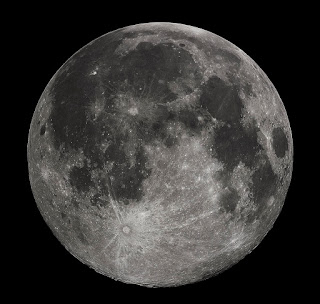If blue moon isn't blue, then what is it? A blue moon refers to the second full moon in a calendar month. The moon goes through a cycle of phases (new, first quarter, full, third quarter, etc.) over a period of 29.5 days. Since a calender month is slightly longer at 30/31 days, there is a possibility for a phase to repeat itself in a month. For example, if the moon is in a particular phase on the 1st or 2nd of the month, it will have the same phase on one of the last 2 days of the month. Expect a blue moon whenever the moon is in its full phase on the first or second of the month. The next full moon, the blue moon, will occur on the 30th or 31st of the month.
 |
| Gregory H. Revera [CC BY-SA (https://creativecommons.org/licenses/by-sa/3.0)] |
"If there's been a recent forest fire or volcanic eruption that pumped significant smoke or ash into the upper atmosphere, it is possible for the moon to take on a bluish hue. Just such an event made the moon turn blue in late September, 1950, when smoke from a forest fire in Canada drifted down to cause a blue moon over eastern North America. The eruption of Mount Pinatubo in June 1991 created blue moons from various perspectives around the planet."
The moon appearing blue happens on very rare occasions, but has nothing to do with the definition of a blue moon. A blue moon, as in the second full Moon in a month, occurs roughly every 2.5 - 3 years.
It's very possible that your kids may ask about blue moons. It's something they are likely to hear in school. As a parent, do your best to clear up this misconception. Good luck!
Hmmmm....I wonder if this is where the phrase "once in a blue moon" comes from. :)
ReplyDeleteJo